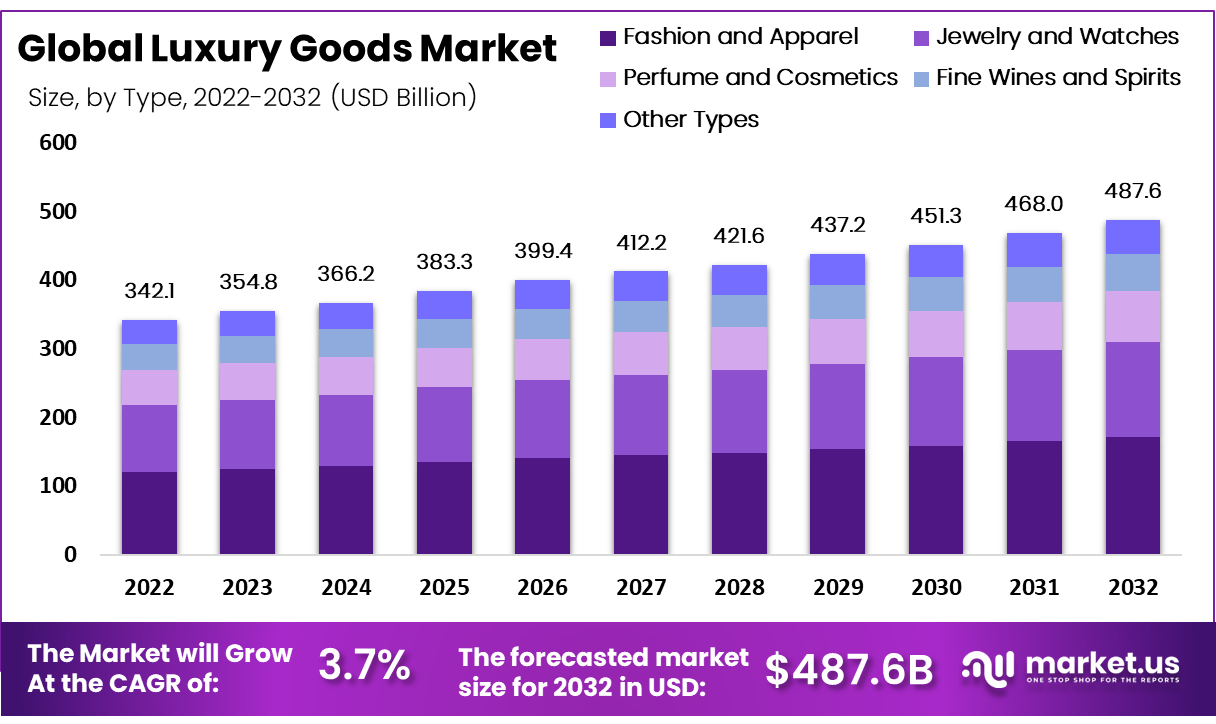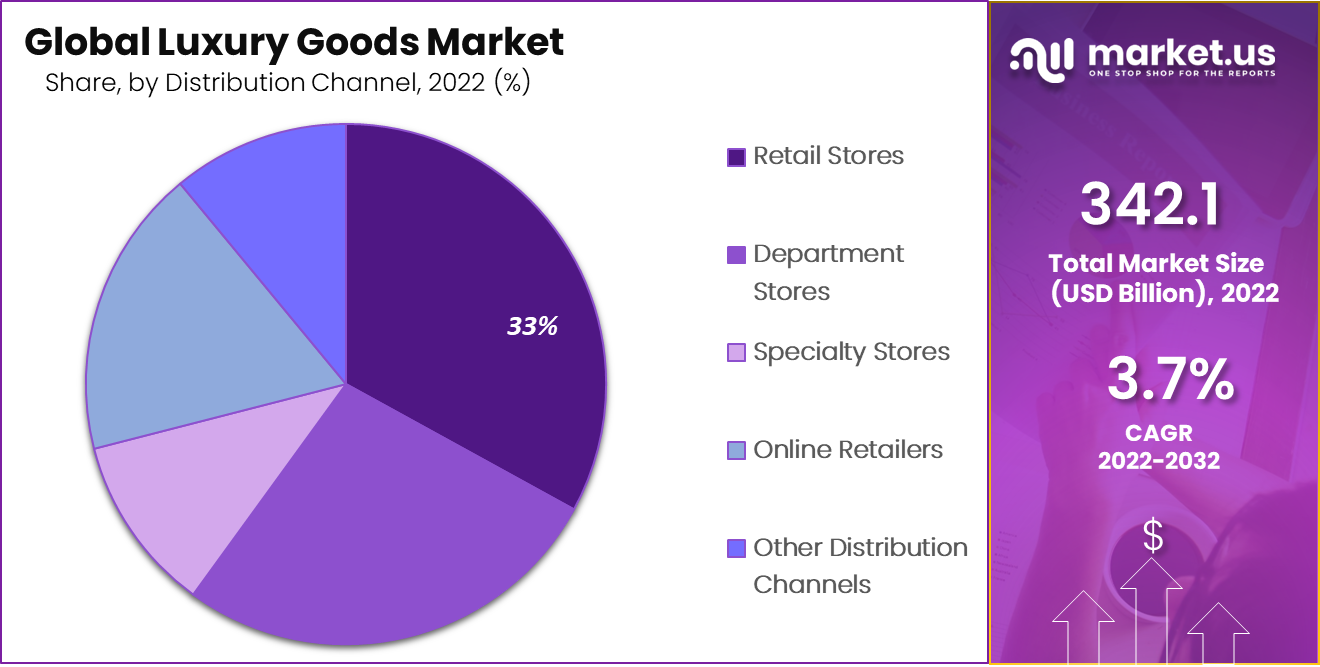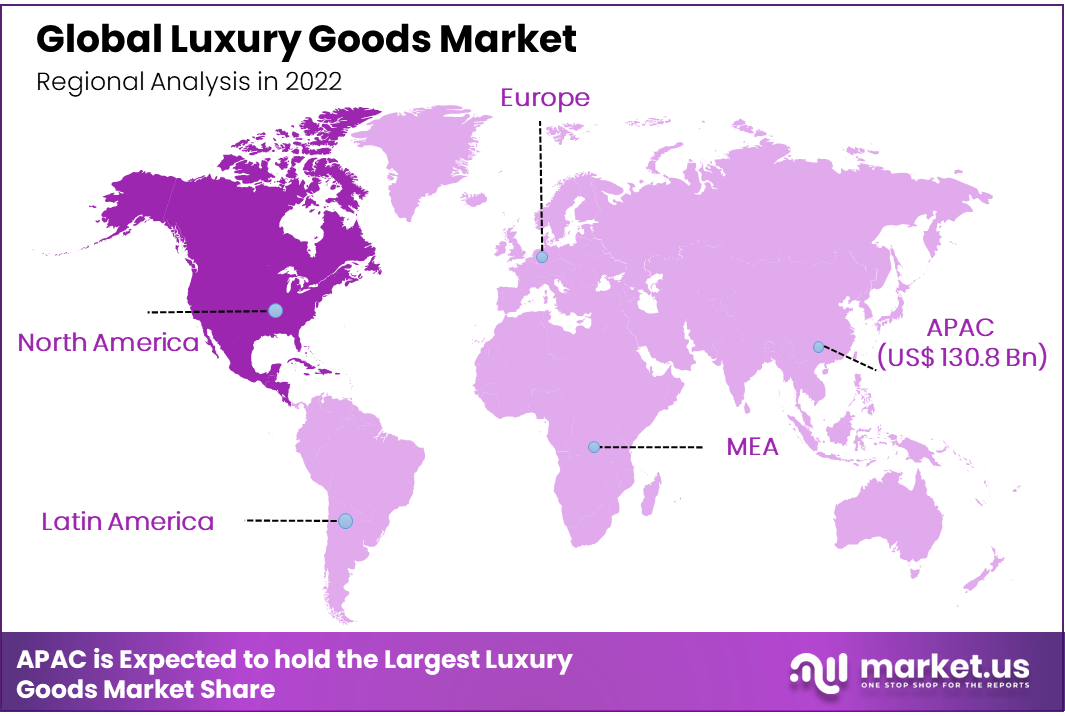Global Luxury Goods Market Size, Trades, COVID-19 Impact & Growth By Type (Fashion and Apparel, Jewelry and Watches, Perfume, and Cosmetics, Fine Wines and Spirits, and Other Types), By End-User (Men and Women), By Distribution Channel (Retail Stores, Department Stores, Specialty Stores, Online Retailers, and Other Distribution Channels), By Region and Companies - Industry Segment Outlook, Market Assessment, Competition Scenario, Trends, and Forecast 2023-2032
- Published date: Oct 2023
- Report ID: 12522
- Number of Pages: 281
- Format:
- keyboard_arrow_up
Quick Navigation
Report Overview
The Global Luxury Goods Market size is expected to be worth around USD 487.6 Billion by 2032 from USD 342.14 Billion in 2022, growing at a CAGR of 3.70% during the forecast period from 2023 to 2032.
Luxury goods refer to high-quality, exclusive, and often expensive products or services that are associated with prestige, social status, and superior craftsmanship. These goods are typically beyond the reach of the average consumer and are targeted at affluent individuals and niche markets.
Luxury goods manufacturers encompass a wide range of categories, including but not limited to fashion apparel and accessories, haute couture, fine jewelry and watches, luxury cars, high-end electronics, premium cosmetics, and personal luxury travel experiences.
The global luxury goods market has experienced significant growth and transformation over the past few decades. The rise of the middle class in emerging economies, particularly in countries like China, India, Brazil, and Russia, has resulted in an increase in disposable incomes and a growing appetite for luxury items, products. As a result, these emerging markets have become crucial players in the luxury goods industry.

*Actual Numbers Might Vary in the Final Report
Driving Factors
The luxury goods market is influenced by several driving factors that contribute to its growth and sustainability. Increasing disposable incomes and rising consumer confidence in both developed and emerging economies have spurred the demand for luxury products.
As people’s purchasing power rises, they are more willing to indulge in premium and exclusive items. Additionally, evolving consumer preferences, particularly among younger demographics, have shifted towards experiential and aspirational consumption, fueling the desire for luxury brands and products.
Furthermore, globalization and the growth key factors of online retail have expanded the reach of luxury goods to new markets, enabling brands to tap into a broader customer base. Luxury goods’ inherent association with status, prestige, and quality has also contributed to sustained demand among affluent consumers seeking to differentiate themselves through luxury purchases.
The industry’s innovation and creativity, along with effective marketing and brand storytelling, continue to be pivotal in attracting and retaining customers, making the luxury goods market an ever-evolving and thriving sector.
Restraining Factors
Economic downturns and fluctuations in global financial conditions can significantly affect consumer spending on non-essential items, leading to a decline in luxury purchases. Moreover, geopolitical uncertainties, trade disputes, and regulatory changes can create unstable business environments, causing consumers to become more cautious with their discretionary spending.
Additionally, the rise of conscious consumerism has prompted a shift towards sustainability and ethical considerations, challenging traditional luxury brands to adapt their practices and offerings to align with these values. Counterfeit products and the proliferation of online marketplaces have also posed significant challenges, eroding consumer trust and potentially diluting the exclusivity of luxury brands.
Growth Opportunities
The increasing affluence of the global middle class, particularly in emerging markets, has created a larger pool of potential luxury consumers. As disposable incomes rise, more individuals aspire to experience the exclusivity and prestige associated with luxury brands, driving demand for high-end products and experiences.
Furthermore, the rapid growth of digitalization and e-commerce has opened new avenues for luxury brands to reach and engage with a broader audience globally. Online platforms enable seamless shopping experiences and provide opportunities for creative and immersive storytelling, enhancing brand visibility and customer engagement.
Moreover, the growing interest in sustainability and ethical consumption presents an opportunity for luxury brands to differentiate themselves by adopting eco-friendly practices and offering products that align with conscious consumer values. By demonstrating environmental and social responsibility, luxury brands can attract a new generation of consumers who seek authenticity and purpose in their purchases.
Latest Trends
The increasing emphasis on sustainability and ethical consumption is a prevailing trend, driving luxury brands to adopt eco-friendly practices, use sustainable materials, and promote transparency in their supply chains. Consumers, particularly younger generations, are actively seeking products and experiences that align with their values and have a positive impact on the environment and society.
Additionally, inclusivity and diversity have become essential considerations for luxury brands as consumers demand more inclusive representation in marketing campaigns and product offerings that cater to diverse demographics. Influencer marketing and collaborations with artists, musicians, and influencers from different backgrounds are gaining traction to appeal to a broader and culturally diverse audience.
Lastly, the concept of “conscious consumerism” is reshaping luxury consumption, with consumers valuing unique and meaningful experiences over conspicuous consumption. Luxury company brands are responding by curating exclusive and immersive experiences, limited-edition releases, and bespoke services to cater to consumers’ desire for authenticity and individuality.
Embracing these trending factors allows sales of luxury goods companies to stay relevant, maintain a competitive edge, and foster meaningful connections with their evolving customer base insights.
Type Analysis
The global luxury goods market can be classified into several key type segments, and key factors each catering to different consumer preferences and lifestyle choices. Fashion and Apparel is one of the largest segments, encompassing high-end clothing, accessories, and footwear from renowned luxury category fashion houses.
It caters to consumers seeking to express their individuality and status through exclusive and stylish designs. The Jewelry and Watches segment offers luxurious and exquisite pieces, often adorned with precious stones and metals, appealing to consumers who value craftsmanship, elegance, and lasting value.
Perfume and Cosmetics is another significant segment, featuring premium fragrances and beauty products that evoke sophistication and indulgence. Fine Wines and Spirits cater to connoisseurs and collectors, offering rare and high-quality alcoholic beverages that signify taste and refinement.
Lastly, the “Other Types” segment encompasses a diverse range of luxury products, such as high-end home décor, fine art, luxury cars, and exclusive travel experiences, providing customers with a wide array of luxury choices to suit their individual preferences and passions.
The global luxury goods market has witnessed steady growth across these types of segments, driven by rising disposable incomes, urbanization, and changing consumer lifestyles. Asia-Pacific has emerged as a prominent market for luxury goods, with countries like China and India contributing significantly to the industry’s expansion. The growth of e-commerce and digital marketing has also played a crucial role in reaching a broader consumer base and enhancing brand visibility worldwide.
Moreover, the growing demand for sustainable and ethically sourced luxury products has prompted many brands to focus on environmentally friendly practices and social responsibility, resonating with conscious consumers. As the market continues to evolve, the type segments within the luxury goods industry are likely to witness further innovation, embracing digital technologies and sustainability efforts to stay relevant and cater to the evolving tastes and preferences of the global luxury consumer.
End-User Analysis
The global luxury goods market can be analyzed through its end-user segments, primarily consisting of men and women. Both genders play a significant role in shaping the demand and key trends within the luxury industry. Women have historically been major share consumers of luxury goods, driving sales in fashion, apparel, jewelry, and cosmetics segments. They seek exclusivity, style, and a sense of identity through their luxury purchases.
On the other hand, men’s contribution to the luxury goods market has grown steadily, with a rising interest in high-end fashion, accessories, and luxury watches. As gender norms evolve, more men are embracing luxury products as a means of self-expression and to showcase their taste and status.
The industry continues to witness an increasing focus on gender-inclusive and unisex offerings, reflecting a broader and more diverse consumer base. Catering to the preferences of both men and women is vital for luxury brands to remain competitive and capitalize on the growing global luxury goods market.
Distribution Channel Analysis:
The global luxury goods market relies on various distribution channels to reach its discerning consumers. Retail Stores, particularly exclusive boutiques and flagship stores, have long been a cornerstone of luxury brands, providing a personalized and immersive shopping experience. Department Stores also play a significant role, offering a curated selection of luxury products to a wider customer base.
Specialty Stores cater to specific luxury niches and offer a unique ambiance for consumers seeking highly specialized items. Online channels retailers have emerged as a vital distribution channel, enabling luxury brands to expand their reach globally and engage with tech-savvy customers through e-commerce platforms and virtual experiences.
Embracing digitalization has become crucial for luxury brands to adapt to changing consumer behaviors and preferences. Additionally, Other Distribution Channels, such as luxury events, pop-up stores, and partnerships with luxury hotels or airlines, provide opportunities for exclusive and experiential interactions with high-end consumers.
A multi-channel approach is essential for the success of luxury brands, ensuring they can cater to diverse consumer preferences and enhance their brand presence in the dynamic and evolving global luxury goods market.

Global Luxury Goods Market Segments Includes:
Based on Type
- Fashion and Apparel
- Jewelry and Watches
- Perfume and Cosmetics
- Fine Wines and Spirits
- Other Types
Based on End-User
- Men
- Women
Based on Distribution Channel
- Retail Stores
- Department Stores
- Specialty Stores
- Online Retailers
- Other Distribution Channels
COVID-19 Impact Analysis
The COVID-19 pandemic had a significant and multifaceted impact on the personal luxury goods market. Initially, as the virus spread globally, luxury sector retailers faced widespread store closures and disruptions in supply chains, leading to a sharp decline in sales and revenue.
The travel restrictions and lockdown measures severely impacted tourist spending, which historically accounted for a substantial portion of luxury sales. However, luxury brands adapted swiftly by embracing digitalization, focusing on e-commerce, and engaging customers through virtual experiences and online marketing.
While the overall luxury market largest share experienced a contraction, certain segments like high-end loungewear, home decor, and luxury beauty products saw increased demand as consumers prioritized comfort, wellness, and self-care during prolonged periods of confinement.
Moreover, the pandemic accelerated the importance of sustainability and ethical practices, compelling luxury brands to reevaluate their supply chains and demonstrate social and environmental responsibility. As the world gradually recovers, the demand for luxury goods market recovery will depend on brands’ ability to cater to evolving consumer preferences and embrace innovation while staying true to their core values.
Regional Analysis
The global luxury goods market exhibits varying dynamics across different regions. The Asia-Pacific (APAC) region has experienced a remarkable growth rate in the luxury goods market and holds the majority of the market share at US$ 130.8 Bn in 2022, primarily fueled by the emerging middle class in countries like China and India.
The increasing urbanization, changing lifestyles, and a growing aspirational consumer base have contributed to the region’s prominence in luxury consumption. North American markets boast a strong appetite for luxury products, driven by high disposable income levels, a strong luxury retail presence, and a culture that values status and exclusivity.
The European Union (EU) is another prominent market insight, home to several iconic luxury brands and renowned fashion capitals like Paris and Milan. The EU’s affluent consumers appreciate the rich heritage and craftsmanship associated with luxury products. Additionally, Latin America (LA) has shown potential, with countries like Brazil and Mexico exhibiting a taste for luxury fashion and premium products.
The Middle East and Africa (MEA) also represent a notable market for luxury goods, with luxury tourism and a high concentration of affluent consumers contributing to the industry’s growth. The regional market diversity in the global luxury goods market underscores the significance of understanding cultural nuances, consumer preferences, and economic growth factors to effectively target and capitalize on opportunities across these different regions.

Key Regions and Countries Covered in this Report:
- North America
- The US
- Canada
- Europe
- Germany
- France
- The UK
- Italy
- Spain
- Russia & CIS
- Rest of Europe
- APAC
- China
- Japan
- South Korea
- India
- ASEAN
- Rest of APAC
- Latin America
- Brazil
- Mexico
- Rest of Latin America
- Middle East & Africa
- GCC
- South Africa
- United Arab Emirates
- Rest of the Middle East & Africa
The global Luxury Goods market is highly competitive and fragmented, with a few key players operating in the market. These major players are focusing on expanding their product offerings and strengthening their market image through strategic partnerships.
Market Key Players:
- LVMH Moët Hennessy Louis Vuitton SE
- Kering S.A.
- Cie Financiere Richemont SA
- Richemont
- Giorgio Armani S.p
- Ralph Lauren Corporation
- Luxottica Group S.p.A.
- Estée Lauder Companies Inc.
- L’Oréal Luxe
- Hermès International
- Prada S.p.A.
- Rolex SA
- Chanel
- Burberry Group Plc
- Other Key Players
Recent Developments:
- In November 2022: The multinational cosmetic corporation, Estee Lauder Companies, Inc., acquired the luxury goods company, Tom Ford, known for its high-end footwear, bags, and accessories. This acquisition aims to broaden its reach in the luxury beauty products market in China.
- In March 2022: Shiseido revealed its plan to introduce a new clean beauty label, Ule, reinforcing its focus on skin beauty. The Japanese personal care company aims to enhance its skin beauty collection to constitute 75% of its total revenue in 2022.
Report Scope:
Report Features Description Market Value (2022) US$ 342.14 Bn Forecast Revenue (2032) US$ 487.6 Bn CAGR (2023-2032) 3.7% Base Year for Estimation 2022 Historic Period 2016-2022 Forecast Period 2023-2032 Report Coverage Revenue Forecast, Market Dynamics, COVID-19 Impact, Competitive Landscape, Recent Developments Segments Covered By Type: Fashion and Apparel, Jewelry and Watches, Perfume and Cosmetics, Fine Wines and Spirits, and Other Types, By End-User: Men and Women, By Distribution Channel: Retail Stores, Department Stores, Specialty Stores, Online Retailers, and Other Distribution Channels Regional Analysis North America: The US and Canada, Europe: Germany, France, The UK, Italy, Spain, Russia & CIS, and the Rest of Europe, APAC: China, Japan, South Korea, India, ASEAN, and the Rest of APAC, Latin America: Brazil, Mexico, and Rest of Latin America, Middle East & Africa: GCC, South Africa, United Arab Emirates, and Rest of Middle East & Africa Competitive Landscape LVMH Moët Hennessy Louis Vuitton SE, Kering Group, Richemont, Estée Lauder Companies Inc., L’Oréal Luxe, Hermès International, Prada S.p.A., Rolex SA, Chanel, Burberry Group Plc, Other Key Players Customization Scope Customization for segments, region/country-level will be provided. Moreover, additional customization can be done based on the requirements. Purchase Options We have three licenses to opt for: Single User License, Multi-User license (Up to 5 Users), Corporate Use License (Unlimited User and Printable PDF) Frequently Asked Questions (FAQ)
What is the Luxury Goods Market Size in the Year 2022?The Global Luxury Goods Market size was USD 342.14 Billion in 2022, growing at a CAGR of 3.70% during the forecast period.
What is the Luxury Goods Market CAGR During the Forecast Period 2023-2032?The Global Luxury Goods Market size is growing at a CAGR of 3.70% during the forecast period from 2023 to 2032.
What is the Luxury Goods Market Size During the Forecast Period 2023|2032?The Global Luxury Goods Market size is expected to be worth around USD 487.6 Billion by 2032 during the forecast period.

- LVMH Moët Hennessy Louis Vuitton SE
- Kering S.A.
- Cie Financiere Richemont SA
- Richemont
- Giorgio Armani S.p
- Ralph Lauren Corporation
- Luxottica Group S.p.A.
- Estée Lauder Companies Inc.
- L'Oréal Luxe
- Hermès International
- Prada S.p.A.
- Rolex SA
- Chanel
- Burberry Group Plc
- Other Key Players
- settingsSettings
Our Clients
| Single User $4,599 $3,499 USD / per unit save 24% | Multi User $5,999 $4,299 USD / per unit save 28% | Corporate User $7,299 $4,999 USD / per unit save 32% | |
|---|---|---|---|
| e-Access | |||
| Report Library Access | |||
| Data Set (Excel) | |||
| Company Profile Library Access | |||
| Interactive Dashboard | |||
| Free Custumization | No | up to 10 hrs work | up to 30 hrs work |
| Accessibility | 1 User | 2-5 User | Unlimited |
| Analyst Support | up to 20 hrs | up to 40 hrs | up to 50 hrs |
| Benefit | Up to 20% off on next purchase | Up to 25% off on next purchase | Up to 30% off on next purchase |
| Buy Now ($ 3,499) | Buy Now ($ 4,299) | Buy Now ($ 4,999) |












